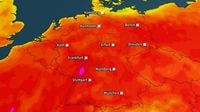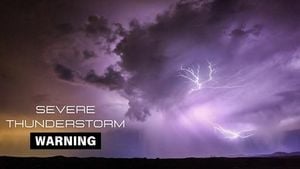As May approaches, the anticipation of the Eisheiligen, or Ice Saints, looms large in Germany, bringing with it a blend of hope and trepidation for farmers and gardening enthusiasts alike. This traditional weather phenomenon, spanning from May 11 to May 15, is steeped in folklore and is known for its potential to usher in late frosts that could jeopardize delicate plants just as spring seems to take hold.
The Eisheiligen are named after five saints: Mamertus (May 11), Pankratius (May 12), Servatius (May 13), Bonifatius (May 14), and Sophia, also known as "Kalte Sophie" (May 15). These dates are critical for hobby gardeners, as old farmer's rules caution against planting frost-sensitive crops before mid-May. According to tradition, the arrival of the Eisheiligen signals a time when cold air intrusions are likely, which can lead to frost at night, posing a significant risk to young plants.
For instance, the Deutscher Wetterdienst (DWD) notes that the second decade of May has historically been a period where cold air masses often sweep into the region. As such, it is advisable for gardeners to wait until after May 15 to plant sensitive vegetables like tomatoes, zucchini, cucumbers, and beans. Doing so can prevent the heartbreaking loss of budding crops to unexpected frost.
Weather forecasts indicate that the beginning of May 2025 will start off relatively warm, with temperatures in some regions potentially reaching up to 30 degrees Celsius. For example, the Upper Rhine area between Mainz and Freiburg is expected to experience warm weather, while cities like Berlin and Hamburg are predicted to see temperatures between 24 and 28 degrees Celsius. However, this warm spell may be short-lived, as a sudden drop in temperatures is anticipated from Thursday to Friday, particularly in Schleswig-Holstein, where nighttime temperatures could dip below 10 degrees Celsius.
In Neumünster, the forecast suggests a significant temperature drop from 23 degrees Celsius on Thursday to just 16 degrees Celsius on Friday. Similarly, Greifswald is expected to see a decrease from 22 degrees to 16 degrees. This cold air mass, moving southward, could lead to brief ground frost in northern areas as early as the night before the Eisheiligen.
Experts are divided on the significance of the Eisheiligen in modern weather patterns. Some meteorologists, like Dominik Jung, suggest that after the warm days at the end of April, a temperature drop of 15 to 20 degrees Celsius is plausible. However, the DWD's 10-day forecast for Hessen indicates that daytime temperatures will remain around 20 degrees Celsius, dropping to about 5 degrees at night, which may not be cold enough to cause severe frost damage.
Despite the historical significance of the Eisheiligen, some experts argue that their impact on weather patterns has diminished in recent years. The DWD points out that frost-sensitive vegetation periods are occurring earlier than in the past, possibly due to climate change. As a result, the direct influence of the Eisheiligen on agriculture and gardening may not be as pronounced as it once was.
Moreover, the 100-year calendar, a traditional weather forecasting tool based on observations by Abbot Mauritius Knauer in the 17th century, suggests that significant rain is expected in Germany from May 7 to May 16, 2025. This forecast implies that while the Eisheiligen may bring cooler temperatures, the overall moisture levels could be beneficial for crops if the frosts do not materialize.
In fact, the calendar states, "Pankratius, Servatius, Bonifatius, the winemaker must heed: if they pass without rain, it brings great blessing to the wine." This saying highlights the importance of the Eisheiligen not just for frost concerns but also for the quality of crops, particularly grapes, which are sensitive to late frosts.
As gardeners prepare for the upcoming weeks, the advice remains clear: caution is key. It is recommended to monitor weather forecasts closely and be prepared to take protective measures if cold snaps are predicted. While the likelihood of severe frost during the Eisheiligen may be low, the potential for brief cold periods still exists. Therefore, delaying the planting of sensitive plants until after the Eisheiligen can safeguard against the unpredictable nature of spring weather.
In conclusion, the Eisheiligen serve as a reminder of the delicate balance between nature and agriculture. As the warm days of spring unfold, the specter of frost still lingers, urging gardeners to remain vigilant. With the potential for both warmth and cold in the coming weeks, the Eisheiligen encapsulate the unpredictability of spring, making them a crucial period for anyone invested in the earth's bounty.





